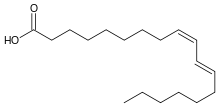Conjugated fatty acid
Conjugated fatty acids are polyunsaturated fatty acids in which at least one pair of double bonds are separated by only one single bond.[1] An example of a conjugated fatty acid is the conjugated linoleic acid. Conjugated fatty acids may confer health benefits ranging from the prevention of hypertension to protection against certain forms of cancer, although more research is needed to confirm such effects.[2]
The conjugation results in delocalization of electrons along the double-bonded carbons.
See also
References
- ↑ Rawat, Richa; Yu, Xiao-Hong; Sweet, Marie; Shanklin, John (26 March 2012). "Conjugated Fatty Acid Synthesis". Journal of Biological Chemistry. 287: 16230–16237. doi:10.1074/jbc.M111.325316. PMC 3351362.
- ↑ Nagao, K; Yanagita, T. "Conjugated fatty acids in food and their health benefits". Journal of Bioscience and Bioengineering. 100 (2). PMID 16198256.
This article is issued from
Wikipedia.
The text is licensed under Creative Commons - Attribution - Sharealike.
Additional terms may apply for the media files.
